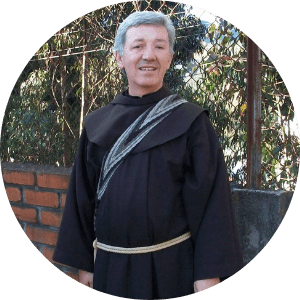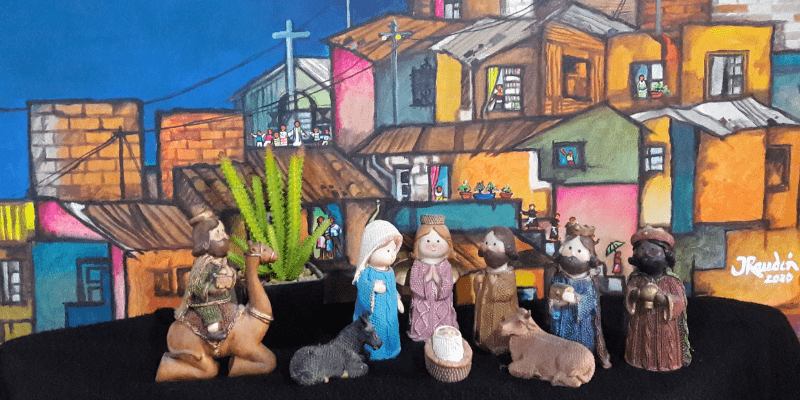
Juan Rendón, OFM
San Pablo Province
JPIC Animator
Sisters and Brothers
PEACE and ALL GOOD
At the centre of the Feast of Christmas is Jesus, the son of Mary and Joseph, the Nazarene who walked the dusty streets of his little town and lived in a neighbourly and friendly way. That Jesus who learned the trade of his father Joseph and experienced the wonder of profound human relationships with his fellow townspeople. Jesus who learned from Mary that God is a father with a mother’s heart, a God who looks out the window awaiting the return of the son who left home.
That Jesus whom Francis wished to see with his own eyes on Christmas night 1223 in the little remote town of Greccio. The Jesus of the First Admonition who is made flesh in Bethlehem and becomes bread on the altar through the hands of the priest.
Brother Francis already had friendly relations with the inhabitants of that place; some say he had been visiting since 1217. There he was especially friendly with the family of a man called John who helped him prepare that event which is so beautifully portrayed in the First Life of Thomas of Celano, nos 84-87:
“Some fifteen days before the Nativity of the Lord blessed Francis called for the man, as he often did, and said: ‘If you want us to celebrate the present feast of Our Lord at Greccio, go with haste and diligently prepare what I tell you.’”
To the message he was sending to John, his friend, Francis adds the reasons for celebrating the feast:
“For I wish to do something that will recall to memory the little Child who was born in Bethlehem and set before our bodily eyes in some way the inconveniences of his infant needs, how he lay in a manger, how with an ox and an ass standing by, he lay upon the hay where he had been placed.”
Remembrance, contemplation, suffering, inconvenience, marginalisation. These are essential elements needed to enter into the celebration which has a spiritual richness that enthuses, and which as for all artistic creation, according to the recent talk of Pope Francis to the artists, has three great movements:
- The first movement is that of the senses, captivated by wonder and astonishment. This initial, exterior dynamic, stimulates the other two, more profound movements.
- The second movement reaches the interior of the person. A composition of colours, words or sounds which has the power to reach the human soul. It awakens memories, images feelings . . .
But the movement which generates art doesn’t stop here, it has
- a third aspect: the perception and contemplation of beauty generate a sense of hope which also irradiates the surrounding world. On this point the external and internal movements join together and have repercussions for social relations: they generate that empathy which enables a person to understand the other, with whom we have so much in common. A new conviviality which is not only vaguely expressed but is perceived and shared.
In the moving description of the First Life of Thomas of Celano we can discern those movements which make our spirituality a “guardian of life and beauty in the world”. Celano writes:
“But the day of joy drew near, the time of great rejoicing came. The brothers were called from the various places; Men and women of the neighbourhood prepared with glad hearts, according to their means, candles and torches to light up the night that has lighted up all the days and years with its gleaming star”.
A fraternal community celebration of men and women who make every effort to light up not only that night but all the days and years, as if Christmas was continuing all that time in an attitude of optimism, vitality and conviviality.
Celano continues:
“The night was lighted up like the day, and it delighted men and beasts. The people came and were filled with new joy over the new mystery. The woods rang with the voices of the crowd and the rocks made answer to their jubilation. The brothers sang, paying their debt of praise to the Lord and the whole night resounded with their rejoicing. The saint of God stood before the manger, uttering sighs, overcome with love, and filled with a wonderful happiness”.
Pope Francis writes in his Apostolic Letter “Admirable signum” signed on December 1st 2019 in the sanctuary of Greccio:
“The enchanting image of the Christmas crèche, so dear to the Christian people, never ceases to arouse amazement and wonder. The depiction of Jesus’ birth is itself a simple and joyful proclamation of the mystery of the Incarnation of the Son of God. As we contemplate the Christmas story, we are invited to set out on a spiritual journey, drawn by the humility of the God who became man in order to encounter every person. We come to realize that so great is his love for us that he became one of us, so that we in turn might become one with him.
With this Letter, I wish to encourage the beautiful family tradition of preparing the nativity scene in the days before Christmas.”
We learn this from childhood when Dad and Mum, together with the grandparents hand on this joyful tradition which has a rich popular spirituality .
In the sitting-room of the houses, in the churches, streets, commercial centres, schools, hospitals and prisons this spirituality of the people builds, as it were an altar on which appear traces of that reality where God is revealed every day.
The cribs reflect the geography of the place where they are built: mountainous in the Andes, rivers and lagoons and huge trees in Amazonia, seas and palm-trees in the Caribbean, deserts, volcanoes and snowy mountains in others, with houses of adobe or cardboard and roofs of palm or straw. Some with buildings, cars, avenues or bridle-paths. All representing a reality where God is to be found.
The people who appear in these Nativity scenes dress according to the custom of the locality where the child God continues to be born: people wearing ponchos, Colombian ruanas, coloured skirts, Andaen hats with ear-flaps, straw sombreros, strong colours, fuchsia, orange, yellow-green which contrast with the black of the materials woven on artisan looms. There are found the typical activities: country people working in their vegetable gardens, markets selling fruit, cereals; domestic animals, fishermen.
In the crib we show our contrasting realities but especially the firm decision to build and rebuild our lives as God wants us, even in the difficult times of the present.
In conclusion Pope Francis says in his letter Admirable signum:
“Dear brothers and sisters, the Christmas crèche is part of the precious yet demanding process of passing on the faith. Beginning in childhood, and at every stage of our lives, it teaches us to contemplate Jesus, to experience God’s love for us, to feel and believe that God is with us and that we are with him, his children, brothers and sisters all, thanks to that Child who is the Son of God and the Son of the Virgin Mary. And to realize that in that knowledge we find true happiness. Like Saint Francis, may we open our hearts to this simple grace, so that from our wonderment a humble prayer may arise: a prayer of thanksgiving to God, who wished to share with us his all, and thus never to leave us alone.”
The spirituality of Christmas and of the crib, a spirituality of peace that is committed to life, which as Saint Francis of Assisi shows, and according to what Pope Francis says, frees us from all desire to dominate others, makes us understand the difficulties of those who are the last of all and impels us to live in harmony with all. A harmony that is linked to beauty and truth.
HAPPY CHRISTMAS
TO EVERYBODY
PEACE AND ALL GOOD

